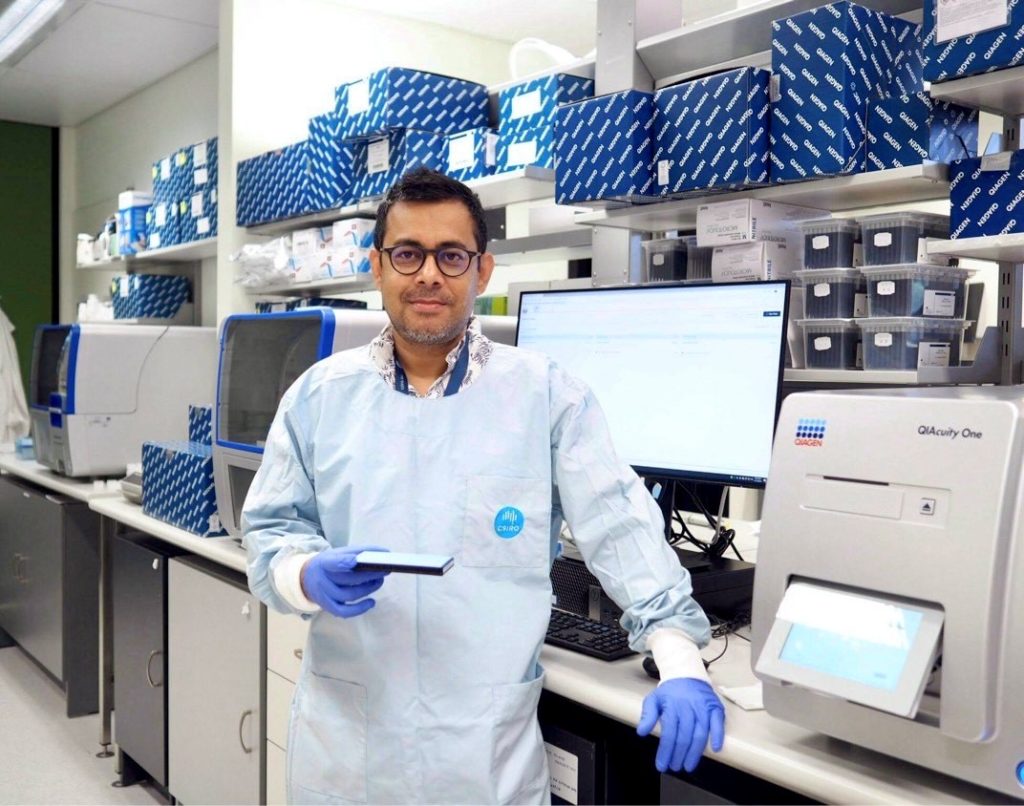
Meet Dr Warish Ahmed. He researches wastewater testing, which finds the presence of SARS-CoV-2 in sewage and other wastewater. He also features in our October science quiz!
We’re always talking about how great our researchers are. They help Traditional Owners monitor biodiversity, negotiate international treaties and influence the next generation of STEM professionals. We are so proud of the work they do!
Our October science quiz highlights some of our featured people and their research.
So, are you ready? It’s quiz-ness time.
Results
#1. Dr Warish Ahmed is leading a team analysing wastewater samples. His work tracks the presence of SARS-CoV-2 in the community. In what environment what this research tested?
Our scientists demonstrated how on-board testing of wastewater on cruise ships is effective in detecting SARS-CoV-2 before passengers disembark. This technique can also be used to detect the virus in smaller populations, like aged-care facilities, schools and prisons.
#2. We worked on two projects that are finalists in the 2020 Eureka Prizes. What were the projects?
The finalists are the Kakadu NESP team and the Indigenous STEM Education Project. The Marine Debris Team and Smart Infrastructure Team were finalists from previous years.
#3. Our big story of the month was understanding the survivability rate of COVID-19 on different surfaces. At 30°C, how long could the virus survive on stainless steel, money (polymer banknotes) and glass?
Seven days! That’s a long time. Find out how long the virus survives on five other common surfaces.
#4. A genomics student, Karla Heric, interned with us and described it as a 'dream internship'. What team did she intern with?
Karla reached out the molecular genetics team in Geelong and ended up doing a summer internship at the lab. She described the experience as her ‘dream internship’.
#5. When working on the 2020 Eureka Prizes finalist project on para grass in Kakadu National Park, what land does Dr Perry Justin work on?
Justin and his team work on Bininj Country alongside Traditional Owners, rangers, park managers, software engineers and other scientists. Find out more about Justin and his work.
#6. Astronomer Dr Chenoa Tremblay uses supercomputing power to find and study atoms and molecules in interstellar space. How many other researchers are currently using the Pawsey Supercomputing Centre in Perth, Western Australia?
It’s 1600 researchers! Postdoctoral Fellow in Dark Magnetism, Dr Chenoa Tremblay, uses supercomputing power to find and study atoms and molecules in interstellar space. And the Pawsey supercomputer recently got an upgrade!
#7. Our new research suggests there’s a staggering 8 to 14 million tonnes of microplastics on the seafloor. This is huge. But it’s still a fraction of the amount of plastic dumped into the ocean. How many tonnes of plastic do we think enter the sea each and every year?
There’s a staggering 8-14 million tonnes of microplastic on the seafloor. This is up to 35 times more than the estimated weight of plastic pollution on the ocean’s surface.
#8. Our astrophysicist Dr Sarah Pearce recently represented Australia in the international negotiations to establish the Square Kilometre Array Observatory as an intergovernmental organisation. Was Australia the only country to be led by a woman throughout the negotiations?
We used scientific literature reviews and media reports on illegal fishing from the last five years for our study. The data showed the main crimes associated with illegal fishing were violations of worker’s rights, forced labour or modern slavery.
#9. The ‘G-strain’ of SARS-CoV-2, the virus causing COVID-19, is now the most dominant strain of the virus worldwide. What was the first strain version of this virus?
The ‘D-strain’ was the initial version of the virus. But SARS-CoV-2 kept mutating as it spread. A new strain bumped the ‘D-strain’ out of the top spot. It’s called the ‘G-strain’ or the D614G mutation. And it now accounts for about 85 per cent of cases worldwide
#10. Dr John Roberts is one of our researchers who looks at biosecurity threats to Australian honey bees. One of these threats is the Varroa mite. How does the Varroa mite hurt the honey bee?
The mite attaches to the bee’s body and sucks on their ‘fat body’. This is a part of the body that plays a huge role in energy production, growth and immunity. As the mite feeds, the bee becomes severely weakened and the open wounds enable the spread of deadly viruses. Learn more about Dr John Roberts research.
While we’re talking about our people, have you seen out meet the researchers series? We chat to a senior microbiologist on food safety, a researcher who is helping Australian businesses manufacture face masks, and a leader looking at AI and machine learning.
What’s your score? We want to know how good your memory is and how well you did in our quiz! Tell us your score in the comment section below.
Want to improve your score next month? Follow us on LinkedIn, Instagram, Twitter or Facebook.





3rd November 2020 at 4:09 am
1—Proofing of text needed.
2—Varroa start in the (drone) brood cell:
The Varroa mite life cycle consists of the following stages: Adult female Varroa mites enter honey bee brood cells (especially drone brood) at the pre-capping stage and lay two to five eggs after the brood cell is capped. … It takes about 5–6 days for male Varroa mites to develop and 7–8 days for female mites to develop.